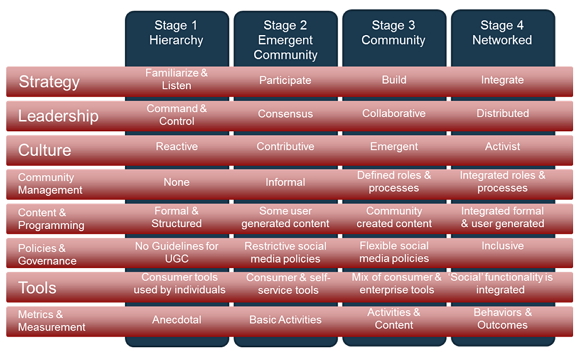Yes. Online community management is a thing.
It is not only a thing that is studied and implemented by organizations across the globe, but it is an opportunity. Online community management can make your company a lot of money, keep the customers you have, and reduce your overall cost of doing business.
At a recent technology conference, Jim Storer, Maggie McGary, and I walked executives through 8 ways that online community management can help your company get more from your online customer or member community.
8 Habits of Highly Effective Online Community Managers from Socious
The session, entitled 8 Habits of Highly Effective Online Community Managers, is based on the 8 competencies of The Community Roundtable’s Community Maturity Model (down the left side).
Let’s get started!
What is Online Community Management?
Online community management involves overseeing and facilitating interactions in digital communities, typically on social media, forums, or websites.
It includes engaging with members, moderating discussions, creating and curating content, managing community guidelines, and analyzing engagement data to foster a healthy, active, and inclusive community environment.
How To Manage An Online Community So That It Works For Your Organization And Your Customers
Here are the 8 tips extracted from the lecture:
Tip #1) Strategy: Become Obsessive About Knowing What Makes Your Members Tick
As Jim Storer put it, “Your ‘sweet spot’ for community is at the intersection of your organization’s goals and your target member’s needs and interests.”
However, you can’t design and manage a community that provides value to your customers or members without deeply understanding who they are, what they want, and how they want that value delivered.
Tip #2) Leadership: View Social as a Natural Extension of What You Already Do Offline
Online communities represent a giving up of control in the eyes of many executives. However, many of the people in your company already manage, and participate in, your customer community using the phone, email, and in-person events.
Tip #3) Culture: Shift From a “Transaction” to a “Relationship” Based Mindset
Companies and their online communities thrive when relationships and the health of relationships are seen as a business asset and performance indicator respectively.
Set forth a culture where everyone is empowered with a little “community management mojo” to understand that they are partly responsible for maintaining and strengthening the community.
Tip #4) Community Management: Continuously Advocate for Having Resources Dedicated to Community Management
Community management is also not magic. Online communities don’t exist and thrive without hard working community managers behind the scenes. Community management needs dedicated staff, authority, and access to strategic information to truly bring home the ROI.
Tip #5) Content & Programming: Weave Community Stuff into Other Communications
Program planning and content coordination are two of the most important roles that online community managers have. However, managing online customer or member communities does not occur in a vacuum. Take advantage of other customer-facing communication to drive participation in your community. Examples include highlighting hot discussions, new files, and other opportunities for engagement in your customer newsletter.
Tip #6) Policies & Governance: Become Best Friends with Your Risk and Compliance Officers
Risk is part of every online community.
Your organization is now participating in the conversation rather than lobbing the message over the fence to customers. Customer communities run into trouble when the compliance team is not educated on the community strategy and online community management plan.
Since they are extra sensitive to risk, they can to overreact at the decrease in control and spook executives. This often results in a demoralizing early shutdown of the initiative or a embarrassing shutter-start with customers or members.
This can be avoided by making a point to cozy up to your compliance and legal teams early and often throughout your project. An educated risk officer can go a long way toward meeting your goals and deadlines.
Tip #7) Tools: Balance Tools That Create Value and Tools That Create Engagement
When planning for customer engagement strategy, selecting online community software, and incorporating public social networks into community management plan, keep in mind that you need two types of features – features that create value and a reason for members to visit your community (like video libraries and discussions) and features that keep members engaged (like the targeted email engine and gamification tools).
Online community managers need to fight for their own success by fighting to have the right balance of both types of tools.
Tip #8) Metrics & Measurement: Measure the Right Things and Make Adjustments Often
In any business initiative, measuring success is important.
However, not measuring the right things can result in rework and financial losses caused by moving forward under incorrect assumptions.
Online community managers must be aware of these pitfalls and narrow down what is happening and why in their community as much possible by tracking the right ratios consistently over time.
Online Community Takeaway
Online communities that thrive over the long terms to directly contribute to revenue generation, cost control, and using market data to create more profitable products don’t happen by accident.
Likewise, online communities that flounder are not just unlucky.
You and those around you in your organization have more control than you think. By researching and testing online community management approaches, there are things you can do to sustain and grow your online customer of member community.
Start with the 8 habits listed above.
